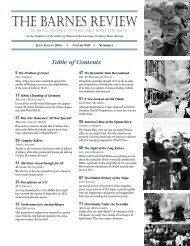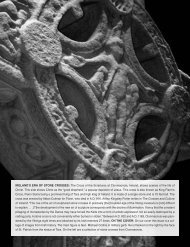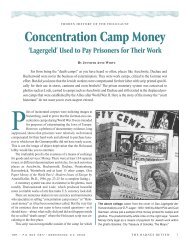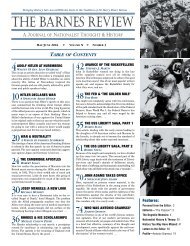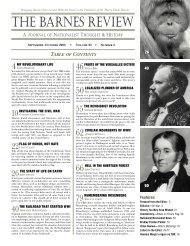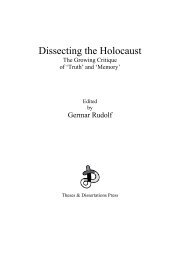Table of Contents - The Barnes Review
Table of Contents - The Barnes Review
Table of Contents - The Barnes Review
You also want an ePaper? Increase the reach of your titles
YUMPU automatically turns print PDFs into web optimized ePapers that Google loves.
Treblinka was opened on July 23, 1942. On this day occurred<br />
the start <strong>of</strong> the mass deportation <strong>of</strong> Jews from Warsaw to that camp.<br />
On November 15, 1942, the resistance movement <strong>of</strong> the Warsaw ghetto<br />
published a long report in which it was pointed out that so far, a<br />
million Jews had been murdered in Treblinka (this comes to 20,000<br />
per day). Fixed gas chambers were not named at all as a murder<br />
weapon; rather, steam chambers, whose functions were described in<br />
detail, were reported, and altogether the eyewitnesses mentioned for<br />
Treblinka no less than 11 different killing methods, which I shall enumerate<br />
here.<br />
1. Exhaust fumes from “poison fuel.”<br />
2. A mobile gas chamber, which was moving along the mass<br />
graves, dumping the bodies, directly.<br />
3. A delayed-action gas, which made it possible for the victims<br />
to walk to their graves. <strong>The</strong>n they would faint and fall into graves.<br />
4. Slaked lime.<br />
5. Electricity (electric current).<br />
6. Shooting with machine guns.<br />
7. Chlorine gas.<br />
8. Steam.<br />
9. Suffocation by pumping air from chambers.<br />
10. Zyklon B.<br />
11. Diesel exhaust gases.<br />
<strong>The</strong> last version became generally<br />
accepted in 1946; and yet in December <strong>of</strong><br />
1945, the Polish government submitted a<br />
paper deeming the Nuremberg Trials, according<br />
to which hundreds <strong>of</strong> thousands <strong>of</strong><br />
people were suffocated with steam at Treblinka<br />
(Nuremberg Document 3311-PS).<br />
According to witness testimonies, the<br />
bodies were buried first in gigantic<br />
mass graves, but later when the<br />
impending German defeat became<br />
obvious, they were burned out in the open,<br />
almost without any fuel. <strong>The</strong> whole Treblinka<br />
legend stands and falls, thus, with the existence <strong>of</strong> these graves. In<br />
August 2000, I spent several days in Treblinka and Belzec with the<br />
young Australian engineer Richard Krege. Belzec was another socalled<br />
extermination camp where 60,000 Jews supposedly were murdered<br />
(according to the wartime version, with electricity, and according<br />
to the after-war version, with Diesel exhaust). Krege worked in the<br />
area <strong>of</strong> these camps with a ground radar instrument, which is used to<br />
find mass graves, but also mineral resources. This instrument shows<br />
disturbances in the soil structure. Neither in Treblinka, nor in Belzec,<br />
was there a zone where giant graves could have been located, nor disturbances<br />
in the ground structure, except at a place in Belzec where<br />
a grave <strong>of</strong> some 100 people could have existed. Richard Krege is publishing<br />
his study which means the final end to these myths.<br />
What was Treblinka if it was not an extermination camp? <strong>The</strong><br />
answer is clear: it was a transit camp. <strong>The</strong> fact that many Jews<br />
passed through Treblinka to Majdanek and other work camps in the<br />
Lublin area is now admitted by the Jewish historians Adam Rutkowski<br />
and Tatjana Berenstein. In 1968, <strong>The</strong> Bulletin <strong>of</strong> the Jewish<br />
Historical Committee in Warsaw published the eyewitness report <strong>of</strong> a<br />
Jew named Samuel Zylbersztain, who came to Majdanek after a<br />
short stay in Treblinka, another alleged “extermination camp.”<br />
Besides the “extermination camp” Treblinka and “extermination<br />
30 N O V E M B E R / D E C E M B E R 2 0 0 3<br />
<strong>The</strong> Jews <strong>of</strong> the ghetto <strong>of</strong> Lodz,<br />
<strong>of</strong> their own free will, and<br />
without any resistance, boarded<br />
the trains to Auschwitz. <strong>The</strong>y<br />
would have known if gas<br />
chambers were waiting for<br />
them. If they had been, they<br />
would not have boarded<br />
those trains.<br />
camp” Majdanek, Zylbersztain survived eight other, ordinary camps,<br />
because the title <strong>of</strong> his testimony is: Memories <strong>of</strong> an Inmate <strong>of</strong> Ten<br />
Camps.” He is a living example that the Germans did not exterminate<br />
the Jews.<br />
Less simple is the pro<strong>of</strong> that Treblinka also served as a transit<br />
camp for the occupied Soviet territories, but, in one case,<br />
at least, there is definite pro<strong>of</strong> <strong>of</strong> this. On July 31, 1942, eight<br />
days before the opening <strong>of</strong> Treblinka, the Reichskommissar<br />
<strong>of</strong> White Russia, Wilhelm Kube, protested in a telegram against the<br />
deportation <strong>of</strong> 1,000 Polish Jews from Warsaw to Minsk. At this time,<br />
all deported Jews from Warsaw came to Treblinka, so that the mentioned<br />
Jews must have been sent via Treblinka. This one transport is<br />
already sufficient to make the thesis <strong>of</strong> Treblinka as a pure extermination<br />
camp tumble like a house <strong>of</strong> cards.<br />
In <strong>of</strong>ficial historiography, the number <strong>of</strong> Jews killed in the east<br />
is given as up to 1.5 million. <strong>The</strong> greatest part <strong>of</strong> the victims were<br />
supposed to have been killed by special deployment troops. So far,<br />
Revisionists have dealt with this topic relatively little, although<br />
Walendy had already, in the early 1980s, objected to the <strong>of</strong>ficial count<br />
<strong>of</strong> victims. A comprehensive investigation about the question <strong>of</strong> special<br />
forces and executions on the eastern front is presently being prepared,<br />
but it will probably take years until its publication.<br />
<strong>The</strong> central argument against the<br />
inflated number <strong>of</strong> killings in the east lies in<br />
the absence <strong>of</strong> pro<strong>of</strong>. After the Soviets had<br />
murdered 4,000 Polish <strong>of</strong>ficers in Katyn, the<br />
Germans found the mass graves <strong>of</strong> the victims,<br />
and they were individually identified.<br />
In the same way, almost all the more than<br />
8,000 Ukrainians who were murdered by the<br />
communists near Vinnitza could be identified<br />
in 1943. It is to be noted that the Soviets<br />
never showed a single mass grave with victims<br />
<strong>of</strong> the Germans that could be compared<br />
with those <strong>of</strong> Katyn or Vinnitza.<br />
<strong>The</strong> most notorious <strong>of</strong> all alleged<br />
German massacres <strong>of</strong> Jews in the east was<br />
that at Babi Yar. On September 29, 1941, no<br />
less than 33,000 Jews were supposed to have been shot there. In the<br />
following months, it is said that 10,000 were added to this. In order<br />
to erase the traces <strong>of</strong> the crime, the Germans supposedly excavated,<br />
two years later, all the corpses and burnt them; this project was<br />
completed in September 1943. But the area around Babi Yar was<br />
photographed on September 26, 1943 by the Air Force. <strong>The</strong> referenced<br />
photograph does not show any trace <strong>of</strong> mass burnings,<br />
indeed, not any recognizable human activity. <strong>The</strong> vegetation and<br />
topography are untouched (John Ball, “Air Photo Evidence” in<br />
Germar Rudolf, Dissecting the Holocaust). Thus it is clearly proven<br />
that the Babi Yar story deals with horror propaganda. Since no<br />
other alleged German massacre on the Eastern Front had been so<br />
propagandistically utilized as that <strong>of</strong> Babi Yar, the logical conclusion<br />
must be that the other alleged mass murder reports were also<br />
either invented or at the least, highly exaggerated.<br />
In the year 1980, the British Jewish historian Walter Laquer<br />
published a popular book entitled <strong>The</strong> Terrible Secret (Wiedenfeld<br />
and Nicolson, London). He proved that Auschwitz was anything else<br />
but an isolated camp and that nothing which occurred in Auschwitz<br />
could have remained a secret for long. <strong>The</strong> Allies, who had an outstanding<br />
communication network, had to find out everything within<br />
weeks; but they never reacted to the horror stories about the exter-



